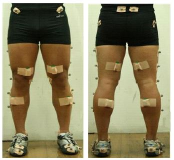
The purpose of this research is to investigate the factors affecting the performance capability of lunge movements by performing lunge movements which are commonly used as a method of instant physical movement in sports with a kinetic analysis including an EMG analysis. This research targeted 14 skilled fencers and made the subjects perform kick-lunges which allow them to go farthest from their positions and performed an analysis on such, applying a 3D motion analysis system and an EMG system. The subjects performed kick-lunges in two movements; one with a preliminary movement and the other without it and those are performed with both dominant leg and non-dominant leg. The result of this research is as follows. The lunges with a preliminary movement showed higher performance capability than those without it. Furthermore, as the level of skills gets higher, the length of lunges gets longer, and it seemed that a tactical mechanism shortening exercise performance times was used as a mechanism to control the impulse coming from such lengthened lunges. In addition, a difference appeared in mechanical factors such as moment and power in a dominant leg movement and it seemed to result from a difference in an functional capability using muscles.


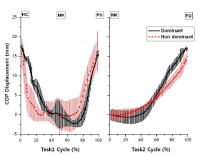



The purpose of this study was to classify high school baseball players as superior or inferior group by Functional Movement Screen(FMS) and to provide basic information for finding great pitcher and improving exercise performance by comparing and analyzing the pitching motion. The results of this study are as follows. The inferior group’s center of mass(COM) moved significant on the left side than superior group at heel contact(HC), ball release(BR), and follow throw(FT)(p<.05). There were no significant difference in linear velocity of shoulder, elbow and wrist between two groups, but inferior groups showed large difference in each joint. The superior group controled rotation of pelvis at HC and showed significant higher knee extension at BR and FT than inferior group(p<.05). The angular velocity of superior group’s throwing arm were higher in acceleration period(p<.05). Taken together based on the results, the players who have higher muscle function showed great pitching motion, so we can conclude that FMS could be useful for evaluating the potential of pitcher.

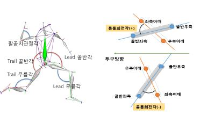
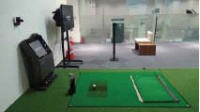
[Purpose] We examined the influence of reactive neuromuscular training (RNT) on golf swing coordination. RNT aims to induce proper coordinative movement by exaggerating the performer’s mistakes. Therefore, we applied RNT using inertia overloading to golfers who have problems with kinematic sequence during a golf swing. [Methods] To examine the effect of 12 weeks of RNT on golf swing coordination, we employed a ball tracking system (launch monitor) and motion analysis system (inertia sensors) were taken on four consecutive periods (pre-test and post-tests 4, 8, and 13 weeks later). Thirty Korean male cadets were divided into three groups based on inertial loading and practiced 7-iron golf swings combined with specific group tasks twice per week. [Results] At pre-test, most participants reached maximal angular velocity near the impact timing (95-100%). However, the deceleration timing of the maximum angular velocity of the proximal segments gradually moved toward mid-downswing as the training sessions proceeded, with the RNT group ultimately outperforming the two control groups. Additionally, the RNT group showed a significantly higher maximum angular velocity in the thorax and wrist. [Conclusion] Our results suggest that RNT can be sufficient to elicit and effective whole-body coordination pattern. Considerable follow-up research is needed on the use of RNT for various sports tasks and the effects of expertise on RNT results.


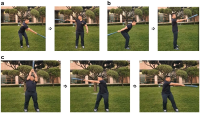
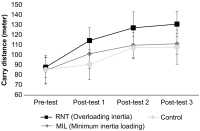
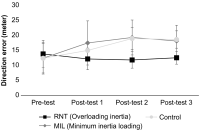



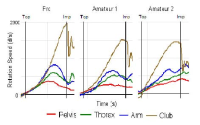
PURPOSE This study aims to analyze the effects of injury prevention video feedback on kinetic variables of the knee joint during the cutting maneuver. METHODS Twenty-eight healthy men participated and motion and force data were collected using infrared cameras, a force plate, and a Witty timing system. Paired t-tests were employed for data evaluation using the SPSS 26.0 program. RESULTS Results showed increased abduction and lateral rotation angles of the knee joint at the lower height of the center of mass (COM) (p<. 05). The lateral rotation of the knee joint decreased at initial ground contact (p<.05). Flexion angular velocity increased at initial ground contact after video feedback (p<.05) and decreased at the lower height of COM (p<.05). Abduction angular velocity decreased at the lower height of COM (p<.05), and internal rotation angular velocity was increased on the initial ground contact (p<.05). Maximum ground reaction force for anterior-posterior and medial-lateral directions increased after video feedback (p<.05). Flexion and internal rotation moments increased, and adduction moment also increased (p<.05). CONCLUSIONS In conclusion , video feedback effectively reduced knee load during the cutting maneuver, contributing to injury prevention for the knee joint.
PURPOSE This study aimed to identify the lower limb muscle activity based on direction prediction presence or absence and gender during side cutting in healthy college students. METHODS The study participants included 14 healthy males and females (8 males; 6 females). All participants ran at full speed for a distance of 12m, and side-cutting was carried out at 45 degrees in a randomly indicated direction and in a fixed direction. Simultaneously, data regarding vastus medialis, vastus lateralis, semitendinosus, and biceps femoris muscle activity of the dominant leg were collected using an electromyography sensor, and data regarding vertical acceleration were collected using an inertial sensor attached to the pelvis. A sync webcam was used for obtaining the initial contact of side cutting and the stance period time. During the 10 milliseconds (pre-activation) prior to the initial contact and 50% of the stance phase (loading phase), vastus medialis, vastus lateralis, semitendinosus, and biceps femoris average muscle activity and hamstring to quadriceps ratio included as variables. RESULTS During the pre-activation and loading phase, the vastus medialis muscle activity of the male group was higher in the unexpected condition than in the expected condition. Furthermore, hamstring to quadriceps ratio was confirmed to be lower under unexpected condition compared to under expected condition during on loading phase. CONCLUSIONS The study results suggest that the risk of anterior cruciate ligament injury may increase with side cutting under unpredictable conditions. It is expected to provide useful information for identifying factors related to knee injury in the general population.

Purpose The present study was set up to investigate the effect of self-regulated learning and selection of feedback on learning of the relative and absolute timing. Methods 48 university student volunteers participated in the experiment and were randomly assigned four groups (n=12 for each) depending on practice task and feedback, namely: 1) self-regulated practice task - self-controlled feedback (self-self), 2) self-regulated practice task - york-controlled feedback (self-york), 3) york-regulated practice task - self-controlled feedback (york-self), and 4) york-regulated practice task - york-controlled feedback (york-york). The task was to examine the temporal timing error and the task goal was to press a computer keyboard 'J' and 'K' alternatively corresponding to time set. Prior to the experiment, the participants had a pre-practice session and then practiced one of three timing tasks provided by an experimenter in the acquisition phase. There were two transfer test to assess adaptability aspects of performing changes related to learning after 24 hours of the acquisition phase. Serial practice was applied in the transfer 1 and an effector transfer was examined in the transfer 2. The dependent variables were a relative timing error that is susceptible to discrepancy between the participant’s key press and the goal patterns and an absolute timing error that is susceptible to discrepancy in the time required to perform the sequence compared to the goal absolute time. Results The results showed that in the pre-test there was no significant difference in both the relative and absolute timing error across four groups. However, in acquisition phase there was a significant difference in both the relative and absolute timing error across block. The relative timing error was different across the group in the transfer test 1, however it was different only between the self-self and york-york group. Lastly, the absolute timing error was not different across the groups in the transfer test 2. Conclusion The findings revealed that the self-regulated strategy is effective to learn the relative timing in the effector transfer.

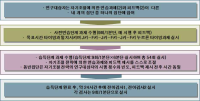





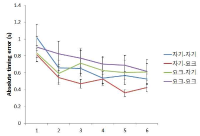



The purpose of this study was to examine the influence 12 weeks of Hatha yoga exercise has upon changes in postural control ability of high school girls. The research subjects were 27 high school girls (yoga group: 15, control group: 12). Changes that took place after yoga exercise were comparatively analyzed after having them train Hatha yoga for 12 weeks. The research variables that were measured were the moving range of COP in static postural balance, Rambling & Trembling in the moving range of COP, and postural change in the sagittal plane. The mean and the standard deviation(SD) were calculated on each measurement item by using the SPSS Ver 21.0 statistical program. To verify difference in pre-value between groups, an independent t-test was carried out. The verification of change according to time within the group after 12 weeks of yoga exercise was conducted in a paired t-test. To inspect interaction by time and group before and after yoga exercise, two-way repeated measures ANOVA was implemented. As a result, the moving distance of the pre and post direction in the moving range of COP was reduced. Rambling and Trembling in the pre-and-post direction significantly decreased. And in postural change of the sagittal plane, there was significant interaction between two groups in the neck and thigh parts. It was thought that the 12 weeks hatha yoga exercise has positive influence upon improving the postural control mechanism in female high school students and has an effect even on change in the postural control ability of an individual.
